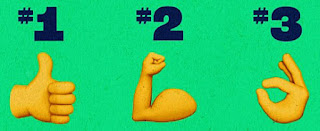Welcome back. Forgive me. I’m certain most of you didn’t need my reminder, but I neglected to alert you that 17 July was World Emoji Day.
For those who may not recognize the word from Japanese, emoji or emojis (either is plural) are pictograms, logograms or ideograms and smileys used in electronic messages and web pages to add emotional cues to typed conversation.
I’ll bet you’ve seen smiley faces. Well, there are 3,521 approved emoji. In recognition of World Emoji Day, the draft candidates for the next emoji release, Emoji 14.0, were revealed along with the results of Adobe’s 2021 Global Emoji Trend Report.
 |
| Examples of candidate emoji for 14.0 release include a melting face, a face holding back tears, new handshake combinations, a gender-neutral person wearing a crown, a pregnant man, a troll with a club and coral (from emojipedia.org/emojipedia/14.0/). |
Although I can’t recall adding an emoji to anything I’ve ever written, I appreciate their creativity. I’ll do my best to tell you about emoji, summarize the trend report and highlight a recent study of how the world uses emoji. To squeeze it all in, I’ll tuck ample references under the P.S.
Emoji Admin
The working list of emoji is determined by the California-based Unicode Consortium. The consortium is a non-profit corporation devoted to developing, maintaining and promoting software internationalization standards and data, particularly the Unicode Standard, which specifies the representation of text in software products and standards.
Consortium members include computer corporations, software producers, database vendors, government ministries, research institutions, international agencies and others.
Emojipedia, a member of the Unicode Consortium, is the central bank of all approved emoji. Emojipedia’s reference website documents the meaning and common usage of each emoji character.
The draft emoji announced on World Emoji Day may change prior to final approval in September. Companies such as Apple, Google and Microsoft apply stylized versions of the consortium's designs to their operating systems, vendor designs vary from those released by major vendors, and Emojipedia's draft images may be updated. The emoji will likely be seen on all platforms by June 2022.
Global Emoji Trend Report
Adobe’s Global Emoji Trend Report for 2021 is based on a survey of 7,000 emoji users in Australia, France, Germany, Japan, South Korea, the U.K. and U.S. Though details of how the survey was conducted weren’t available, I was impressed by some of the results.
 |
| Global emoji users’ top five favorite emoji (from blog.adobe.com/en/publish/2021/07/15/global-emoji-trend-report-2021.html#gs.656huw). |
Global emoji users find emoji make it easier to communicate across language barriers (89% of respondents); can help spark positive conversations about cultural and societal issues (70%); and are an important communication tool for creating unity, respect and understanding (76%).
On the personal side, the users find emoji make it easier to express themselves (90%); are more likely to feel empathetic toward someone if they use an emoji (88%); and are more comfortable expressing emotions through emoji than over the phone (55%) or in-person (51%). They feel that using emoji has positively impacted their mental health (65%).
 |
| The most effective work motivating emoji (from blog.adobe.com/en/publish/2021/07/15/global-emoji-trend-report-2021.html#gs.656huw). |
In the work environment, global emoji users like it when people use emoji (66%). They feel their use helps share ideas quickly (73%); can improve the efficiency of team decision-making (63%); and positively impacts likeability (71%) and credibility (62%).
How the World Uses Emoji
Researchers with the University of Southern California analyzed tens of millions of tweets, in 30 languages and countries, to evaluate how 1,700 emoji are used on Twitter in different linguistic and national contexts.
 |
| Total number of unique emoji (about 600 to 1700) in tweets of 30 different language codes in October 2016 (from www.sciencedirect.com/science/article/pii/S2468696421000318). |
The popularity of emojis, globally and within a given language, seems to follow a robust trend that is language-independent. They emerge quickly, over a single day, and remain largely consistent thereafter.
Findings regarding specific emoji usage and countries, though interesting, may be out of date given that the study relied on data collected over one month in 2016.
Wrap Up
The most important study takeaway was that emoji represent the human condition; we are more alike than different. Universal emotions dominate.
To close, I’ll draw from the Global Trend Report to make the case that you and I should use emoji. Global emoji users think people who use emoji are friendlier, funnier and…get this...cooler than those who don’t (67%). Thanks for stopping by.
P.S.
Emoji:
en.wikipedia.org/wiki/Emoji
unicode.org/standard/standard.html
en.wikipedia.org/wiki/Unicode_Consortium
Emojipedia:
emojipedia.org/
en.wikipedia.org/wiki/Emojipedia
World Emoji Day: en.wikipedia.org/wiki/World_Emoji_Day
Emoji 14.0:
blog.emojipedia.org/new-emojis-in-2021-2022/
emojipedia.org/emojipedia/14.0/
www.dailymail.co.uk/sciencetech/article-9794749/Heres-emoji-set-coming-smartphone-2022.html
Adobe’s 2021 Global Emoji Trend Report: blog.adobe.com/en/publish/2021/07/15/global-emoji-trend-report-2021.html#gs.656huw
Study of emoji usage on Twitter in Online Social Networks and Media journal: www.sciencedirect.com/science/article/pii/S2468696421000318
Article on study on EurekAlert! website: www.eurekalert.org/pub_releases/2021-07/uosc-hdt071321.php

No comments:
Post a Comment